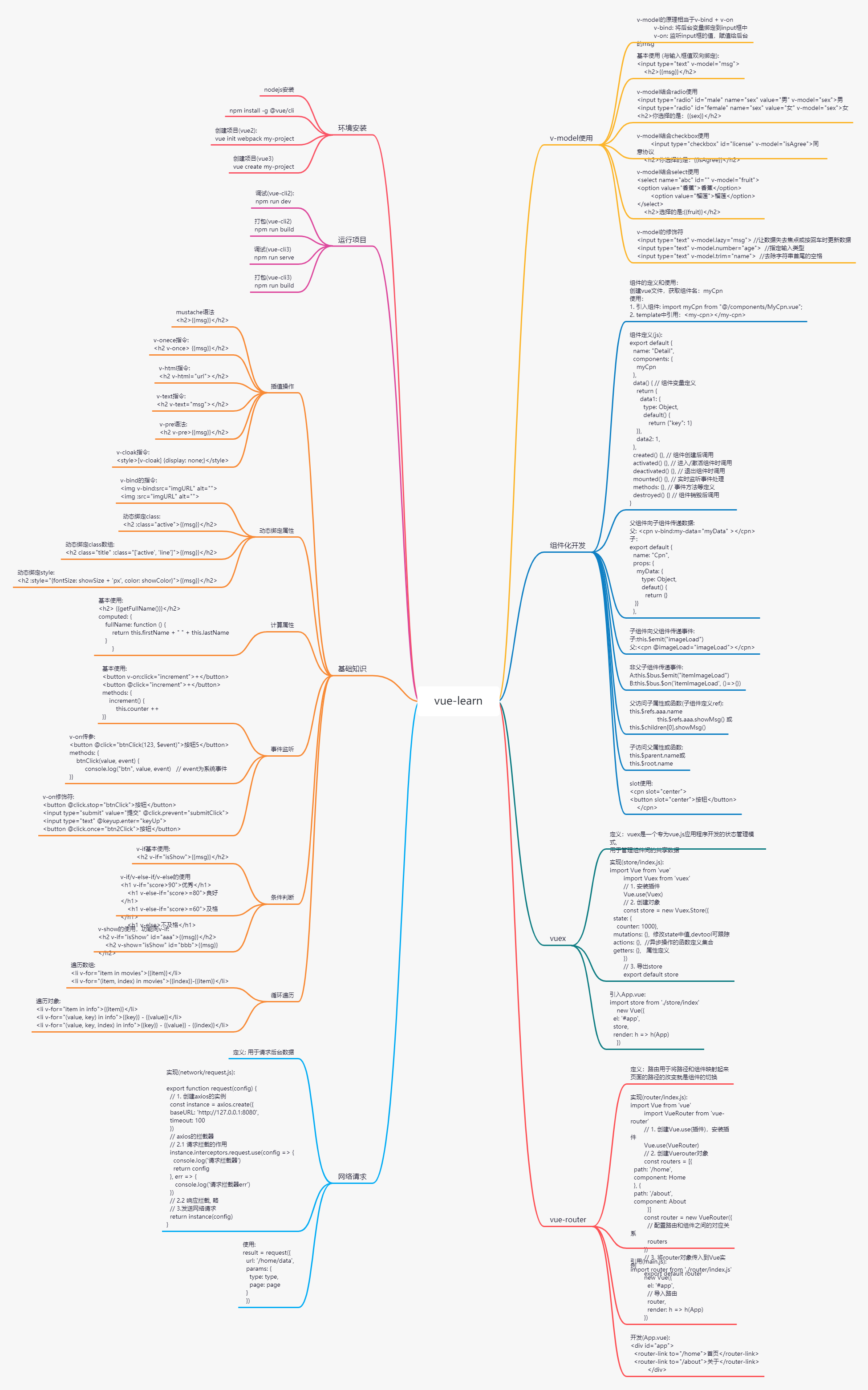下载nodes,并安装
cd 项目实践/supermall的实践/supermall
npm install |vue, axios, better-scroll", vue-load, vue-router, vuex]
npm run serve
npm run build
此文主要针对vue的知识进行梳理,包括环境安装、运行项目、基础知识及一些较为高阶的技术,比如:v-model的使用、 组件化开发、vuex、vue-router和网络请求的封装。
1. 下载nodejs安装
2. npm install -g @vue/cli # -g 表示全局安装
3. vue-cli2初始化项目: vue init webpack [my-project]
4. vue-cli3初始化项目: vue create [my-project]
1. vue-cli2开发环境运行: npm run dev
2. vue-cli2生产环境打包:npm run build
3. vue-cli3开发环境运行: npm run serve
4. vue-cli3生产环境打包: npm run build
- mustache语法
<!-- 1. mustache语法 -->
<h2>{{msg}}</h2>- v-onece指令
<!-- 2. v-onece指令 -->
<h2 v-once> {{msg}}</h2>- v-html指令
<!-- 3. v-html指令 -->
<h2 v-html="url"> </h2>- v-text指令
<!-- 4. v-text指令 -->
<h2 v-text="msg"></h2>- v-pre语法
<!-- 5. v-pre语法 -->
<h2 v-pre>{{msg}}</h2>- v-cloak指令
<!-- 6. v-cloak指令 -->
<style>[v-cloak] {display: none;}</style>- v-bind的指令
<!-- v-bind的指令: -->
<img v-bind:src="imgURL" alt="">
<img :src="imgURL" alt="">- 动态绑定class
<!-- 动态绑定class: -->
<h2 :class="active">{{msg}}</h2>- 动态绑定class数组
<!-- 动态绑定class数组: -->
<h2 class="title" :class="['active', 'line']">{{msg}}</h2>- 动态绑定style
<!-- 动态绑定style: -->
<h2 :style="{fontSize: showSize + 'px', color: showColor}">{{msg}}</h2>- 基本使用
<!-- 基本使用 -->
<h2> {{getFullName()}}</h2>const app = new Vue({
el: "#app",
data: {
firstName: "a",
lastName: "cedar"
},
computed: {
fullName: function () {
return this.firstName + " " + this.lastName
}
}
})- 基本使用
<!--基本使用 -->
<div>
<button v-on:click="increment">+</button>
<button @click="increment">+</button>
</div>const app = new Vue({
el: "#app",
data: {
counter: 0,
},
methods: {
increment() {
this.counter++
}
}
})- v-on传参
<!-- v-on传参 -->
<div>
<button @click="btnClick(123, $event)">按钮</button>
</div>const app = new Vue({
el: "#app",
data: {
counter: 0,
},
methods: {
btnClick(value, event) {
console.log("btn", value, event) // event为系统事件
}
}
})- v-on修饰符
<!-- v-on修饰符 -->
v-on修饰符:
<button @click.stop="btnClick">按钮</button>
<input type="submit" value="提交" @click.prevent="submitClick">
<input type="text" @keyup.enter="keyUp">
<button @click.once="btn2Click">按钮</button>- v-if基本使用
<!-- v-if基本使用:-->
<h2 v-if="isShow">{{msg}}</h2>- v-if/v-else-if/v-else的使用
<!--v-if/v-else-if/v-else的使用-->
<h1 v-if="score>90">优秀</h1>
<h1 v-else-if="score>=80">良好</h1>
<h1 v-else-if="score>=60">及格</h1>
<h1 v-else>不及格</h1>- v-show的使用
<!--v-show的使用,功能同v-if:-->
<h2 v-if="isShow" id="aaa">{{msg}}</h2>
<h2 v-show="isShow" id="bbb">{{msg}}</h2>- 遍历数组
<!--遍历数组:-->
<li v-for="item in movies">{{item}}</li>
<li v-for="(item, index) in movies">{{index}}-{{item}}</li>- 遍历对象
<!--遍历对象:-->
<li v-for="item in info">{{item}}</li>
<li v-for="(value, key) in info">{{key}} - {{value}}</li>
<li v-for="(value, key, index) in info">{{key}} - {{value}} - {{index}}</li>- 定义
v-model说明:
v-model的原理相当于v-bind + v-on
v-bind: 将后台变量绑定到input框中
v-on: 监听input框的值,赋值给后台的msg
- 基本使用
<!--基本使用 (与输入框值双向绑定):-->
<input type="text" v-model="msg">
<h2>{{msg}}</h2>- v-model结合radio使用
<!--v-model结合radio使用-->
<input type="radio" id="male" name="sex" value="男" v-model="sex">男
<input type="radio" id="female" name="sex" value="女" v-model="sex">女
<h2>你选择的是:{{sex}}</h2>- v-model结合checkbox使用
<!--v-model结合checkbox使用-->
<input type="checkbox" id="license" v-model="isAgree">同意协议
<h2>你选择的是:{{isAgree}}</h2>- v-model结合select使用
<!--v-model结合select使用-->
<select name="abc" id="" v-model="fruit">
<option value="香蕉">香蕉</option>
<option value="榴莲">榴莲</option>
</select>
<h2>选择的是:{{fruit}}</h2>- v-model的修饰符
<!--v-model的修饰符-->
<input type="text" v-model.lazy="msg"> //让数据失去焦点或按回车时更新数据
<input type="text" v-model.number="age"> //指定输入类型
<input type="text" v-model.trim="name"> //去除字符串首尾的空格组件的定义和使用:
创建vue文件,获取组件名:myCpn
使用:
1. 引入组件: import myCpn from "@/components/MyCpn.vue";
2. template中引用:<my-cpn></my-cpn>
待补充组件内部执行流程图
- 组件定义(js)
// 组件定义(js):
export default {
name: "Detail",
components: {
myCpn
},
data() { // 组件变量定义
return {
data1: {
type: Object,
default() {
return {"key": 1}
}
},
data2: 1,
}
},
created() {}, // 组件创建后调用
activated() {}, // 进入/激活组件时调用
deactivated() {}, // 退出组件时调用
mounted() {}, // 实时监听事件处理
methods: {}, // 事件方法等定义
destroyed() {} // 组件销毁后调用
}- 父组件向子组件传递数据
// 父:
<cpn v-bind:my-data="myData" ></cpn>
// 子:
export default {
name: "Cpn",
props: {
myData: {
type: Object,
defaut() {
return {}
}
}
}
}- 子组件向父组件传递事件
// 子:
this.$emit("imageLoad")
// 父:
<cpn @imageLoad="imageLoad"></cpn>- 非父子组件传递事件
// 通过事件总线传递
// 组件A,发送事件:
this.$bus.$emit("itemImageLoad")
// 组件B,处理事件:
this.$bus.$on('itemImageLoad', ()=>{})- 父访问子属性或函数(子组件定义ref):
this.$refs.aaa.name
this.$refs.aaa.showMsg()
// 或
this.$children[0].showMsg()- 子访问父属性或函数:
this.$parent.name
// 或
this.$root.name- slot使用:
<cpn slot="center">
<button slot="center">按钮</button>
</cpn>- vuex定义
vuex是一个专为vue.js应用程序开发的状态管理模式,
用于管理组件间的共享数据
- 实现(store/index.js):
import Vue from 'vue'
import Vuex from 'vuex'
// 1. 安装插件
Vue.use(Vuex)
// 2. 创建对象
const store = new Vuex.Store({
state: {
counter: 1000},
mutations: {}, 修改state中值,devtool可跟踪
actions: {}, //异步操作的函数定义集合
getters: {}, 属性定义
})
// 3. 导出store
export default store- 引入(App.vue):
import store from './store/index'
new Vue({
el: '#app',
store,
render: h => h(App)
})- 定义
路由用于将路径和组件映射起来,页面的路径的改变就是组件的切换
- 实现(router/index.js)
import Vue from 'vue'
import VueRouter from 'vue-router'
// 1. 创建Vue.use(插件),安装插件
Vue.use(VueRouter)
// 2. 创建Vuerouter对象
const routers = [{
path: '/home',
component: Home
}, {
path: '/about',
component: About
}]
const router = new VueRouter({
// 配置路由和组件之间的对应关系
routers
})
// 3. 将router对象传入到Vue实例
export default router- 引用(main.js)
import router from './router/index.js'
new Vue({
el: '#app',
// 导入路由
router,
render: h => h(App)
})- 开发(App.vue)
<div id="app">
<router-link to="/home">首页</router-link>
<router-link to="/about">关于</router-link>
</div>- 定义
用于统一请求后台数据
- 实现(network/request.js)
export function request(config) {
// 1. 创建axios的实例
const instance = axios.create({
baseURL: 'http://127.0.0.1:8080',
timeout: 100
})
// axios的拦截器
// 2.1 请求拦截的作用
instance.interceptors.request.use(config => {
console.log('请求拦截器')
return config
}, err => {
console.log('请求拦截器err')
})
// 2.2 响应拦截, 略
// 3.发送网络请求
return instance(config)
}- 使用
result = request({
url: '/home/data',
params: {
type: type,
page: page
}
})本项目是vuejs的学习笔记,预计项目的作用包括两个:
1.入门
2. 开发查找字典
本项目首先对vue的一些基础语法,对应每一个功能点,都有一个或多个html对应,用户可以直接运行html文件,验证所学功能点。
另外,本项目也包含两个实战项目(见'项目实战'目录),'tabbar实战'是一个基础知识的实战项目。'supermall的实践'是一个模拟电商的实践项目,几乎涵盖了vue的所有知识点。
其中有不正确的地方,欢迎大家批评指正。
欢迎大家一起完善、共建。
该项目是基于coderwhy的vuejs教学视频 的学习笔记,其中有小部分组件使用了coderwhy提供的完整版,比如swiper组件,scroll组件等。 感谢coderwhy的分享 项目中使用部分图片是coderwhy中的图片,其他多数图片都是从网站获取 使用本项目的代码或图片资源,请声明来源,禁止用于任何商业行为
